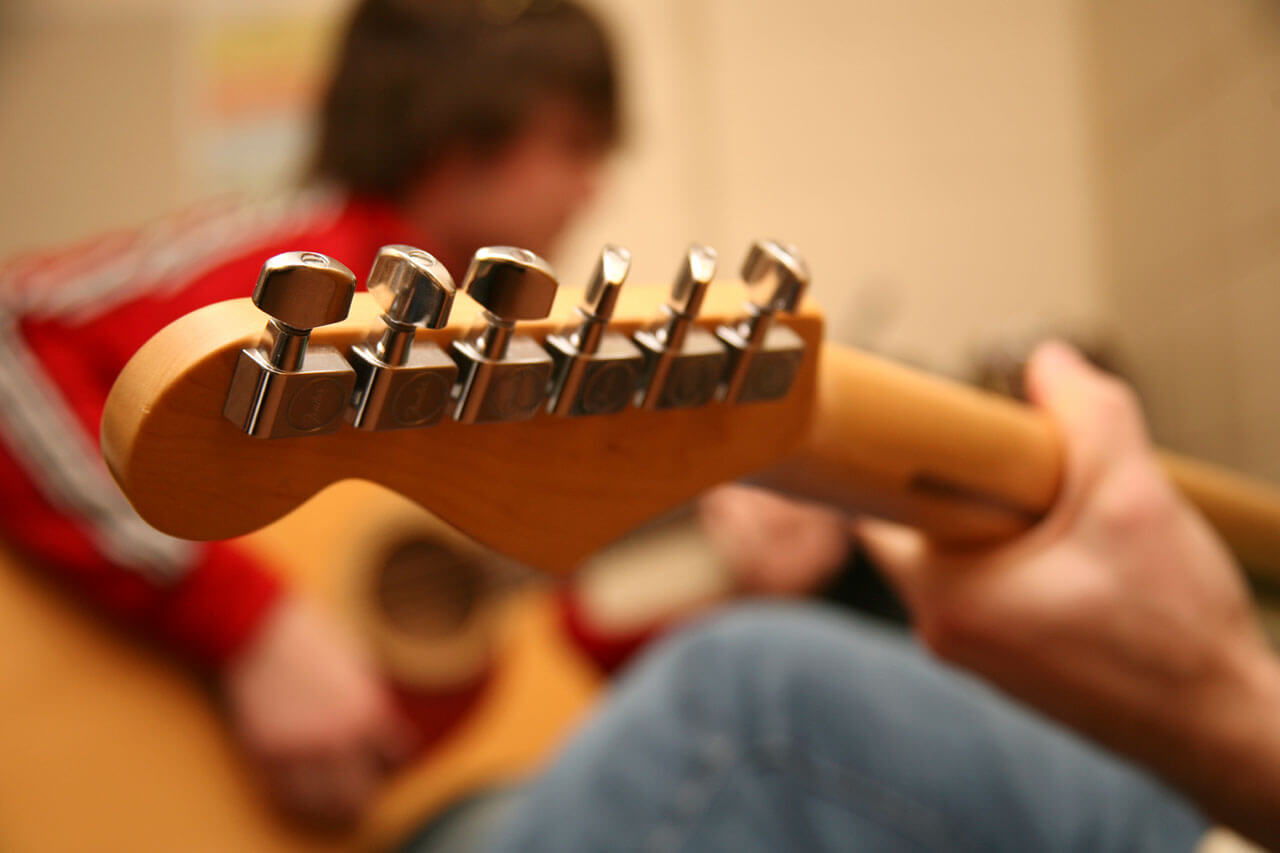
A great guitar teacher
A great guitar teacher
Finding a great guitar teacher is a crucial step in your musical journey. A good teacher can provide personalized guidance, correct your mistakes, motivate you, and help you achieve your musical goals. Here’s a comprehensive guide on how to find a great guitar teacher:
1. Define Your Goals and Preferences
Identify Your Goals:
- Skill Level: Are you a complete beginner, intermediate, or advanced player?
- Music Style: Do you want to learn rock, jazz, classical, blues, metal, or another genre?
- Learning Objectives: Are you looking to improve your technique, music theory knowledge, songwriting skills, or preparation for performances or exams?
Preferences:
- Teaching Style: Do you prefer a structured, formal approach or a more relaxed, flexible style?
- Lesson Format: Are you looking for in-person lessons, online lessons, or a hybrid of both?
- Budget and Schedule: What is your budget for lessons? What days and times are you available?
2. Research Potential Teachers
Local Music Schools and Conservatories:
- Check local music schools and conservatories, which often have qualified teachers with proven credentials.
Music Stores:
- Many music stores offer guitar lessons or have a list of recommended teachers.
Online Platforms:
- We also offer online session‘s which are very popular!
Personal Recommendations:
- Ask friends, family, or other musicians for recommendations. Word-of-mouth referrals can be very reliable.
3. Evaluate Credentials and Experience
Education and Training:
- Look for teachers with formal education in music, such as degrees from recognised music schools or universities. Certifications from reputable programs are also a plus.
Teaching Experience:
- More experienced teachers are likely to have refined their teaching methods and can handle a variety of learning styles and challenges.
Performance Experience:
- Teachers who actively perform can provide practical insights and real-world applications of the skills they teach.
4. Review Teaching Methods and Philosophy
Curriculum and Structure:
- Ask potential teachers about their teaching curriculum. A structured curriculum is important, especially for beginners.
Adaptability:
- A good teacher should be able to adapt their lessons to your specific goals and learning style. They should balance technical skills with practical application.
Emphasis on Theory vs. Practice:
- Some teachers may focus more on music theory, while others might emphasize playing techniques and repertoire. Ensure their approach aligns with your learning preferences.
Supplemental Materials:
- Inquire about the materials they provide, such as lesson plans, practice schedules, or access to online resources.
5. Conduct Interviews or Trial Lessons
Initial Meeting:
- Schedule an initial meeting or trial lesson. This allows you to gauge their teaching style and see if it matches your learning style.
Questions to Ask:
- What is your teaching experience and background?
- How do you structure your lessons?
- What materials do you use?
- Can you provide references or testimonials from current or former students?
- How do you track and assess progress?
- What are your policies on cancellations and make-up lessons?
Assessing Compatibility:
- During the trial lesson, pay attention to how the teacher communicates. Are they clear and patient? Do they provide constructive feedback? Do they make you feel comfortable and motivated?
6. Consider Logistics
Location:
- For in-person lessons, consider the teacher’s location. Is it convenient for you to travel to their studio or home? Alternatively, do they offer home visits?
Online Lessons:
- If you opt for online lessons, check the quality of their setup. Do they use reliable video conferencing tools? Is their internet connection stable? Do they provide clear video and audio?
Lesson Frequency and Duration:
- Decide how often you want to have lessons (weekly, bi-weekly, etc.) and how long each lesson should be (30 minutes, 45 minutes, 1 hour).
7. Evaluate Costs and Policies
Lesson Rates:
- Compare the rates of different teachers. Rates can vary based on experience, location, and lesson length.
Payment Policies:
- Understand the payment policies. Do they require payment per lesson, monthly, or in advance?
Cancellation Policies:
- Be aware of their cancellation and rescheduling policies. It’s important to know the flexibility offered for missed lessons.
8. Seek Feedback and Reviews
Student Testimonials:
- Look for reviews and testimonials from current or former students. Positive feedback from others can be a strong indicator of a teacher’s effectiveness.
Observe Other Students:
- If possible, observe a lesson with another student to see the teacher’s interaction and teaching style.
9. Trust Your Instincts
Comfort Level:
- Trust your instincts about the teacher’s personality and teaching style. You should feel comfortable, respected, and encouraged.
Long-Term Potential:
- Consider whether you can see yourself learning from this teacher over the long term. Building a good student-teacher relationship is crucial for sustained progress.
10. Commit and Review Progress
Regular Review:
- Regularly assess your progress and satisfaction with the lessons. Are you meeting your goals? Are you enjoying the process?
Open Communication:
- Maintain open communication with your teacher. If something isn’t working, discuss it. Good teachers appreciate feedback and are willing to adjust their methods.
Finding a great guitar teacher requires careful consideration and research. Define your goals, thoroughly evaluate potential teachers, and trust your instincts. With the right teacher, you can significantly enhance your guitar playing skills and enjoy a fulfilling musical journey. Remember, the right fit can make all the difference in your learning experience.
Learning to play the guitar
Learning to play the guitar can be a deeply rewarding experience, both creatively and personally. To start your guitar journey effectively, you need a structured approach that balances technical skills, theory, and practical application. Here’s a comprehensive guide on the best way to start learning the guitar.
1. Choosing the Right Guitar
Acoustic vs. Electric:
- Acoustic Guitars: These are generally recommended for beginners due to their simplicity and lack of need for additional equipment like amplifiers. They are portable and offer a clear, resonant sound.
- Electric Guitars: These require amplifiers and can be more physically demanding due to their weight and the need for additional gear. However, they offer a wider range of sounds and are easier on the fingers because of lighter string tension.
Size and Comfort:
- Ensure the guitar fits comfortably in your hands and lap. For children or individuals with smaller hands, a ¾ size guitar or a guitar with a smaller neck might be ideal.
2. Learning Basic Guitar Anatomy and Tuning
Understanding Guitar Parts:
- Familiarize yourself with the parts of the guitar, including the body, neck, fretboard, headstock, tuning pegs, bridge, and strings.
Tuning the Guitar:
- Learn standard tuning: E-A-D-G-B-e (from the lowest, thickest string to the highest, thinnest string). Use an electronic tuner or tuning app to get your guitar in tune. Developing the skill to tune by ear is beneficial as you progress.
3. Developing Proper Technique
Posture and Hand Position:
- Sit comfortably with the guitar resting on your thigh. Ensure a straight back and relaxed shoulders.
- Your fretting hand (usually the left hand for right-handed players) should approach the neck with your thumb behind the fretboard, fingers slightly curved.
- Your picking hand should be relaxed, with a loose grip on the pick. Strumming can be done with fingers or a pick, depending on your comfort.
Basic Strumming and Picking:
- Start with downstrokes and gradually incorporate upstrokes. Practice keeping a steady rhythm.
- Learn alternate picking (down-up-down-up) for more efficient playing.
4. Learning Chords and Transitions
Open Chords:
- Begin with simple open chords such as E minor, A major, C major, G major, and D major. These chords are foundational and appear in many songs.
- Practice changing between these chords smoothly. Start slowly and increase speed as transitions become more comfortable.
Chord Charts:
- Use chord charts to visualize finger placement. Apps and websites can provide interactive chord diagrams.
5. Basic Music Theory
Understanding the Fretboard:
- Learn the notes on the low E and A strings. This will help in identifying chords and scales across the fretboard.
- Memorize the natural notes (A, B, C, D, E, F, G) and understand sharps and flats.
Scales and Keys:
- Start with the major and minor scales. Practice these scales in different keys to build finger strength and dexterity.
- Learn the pentatonic scale, as it is widely used in various music genres and is relatively easy to play.
6. Practice Routine
Consistency:
- Aim for short, regular practice sessions. 15-30 minutes daily is more effective than irregular, longer sessions.
- Include warm-up exercises such as finger stretching and basic scales.
Focus Areas:
- Dedicate time to chord practice, scale exercises, rhythm training, and song learning.
- Use a metronome to develop timing and rhythm accuracy.
7. Learning Songs
Start Simple:
- Choose songs that use the chords and techniques you are comfortable with. Simple folk, pop, or rock songs with a few chords are great starting points.
- Break the song into sections (verse, chorus, bridge) and practice each part separately before combining them.
8. Using Learning Resources
Online Tutorials and Apps:
- Websites like JustinGuitar, YouTube channels, and apps like Fender Play or Yousician offer structured lessons and tutorials.
- These platforms often include interactive features such as backing tracks and real-time feedback.
Books and Sheet Music:
- Guitar method books provide a structured curriculum. The Beginners Guide To Guitar, Hal Leonard Guitar Method and Mel Bay’s Modern Guitar Method are popular choices.
- Learning to read tablature (tabs) is crucial as it’s the most common way guitar music is notated.
9. Seeking Feedback and Guidance
Guitar Teachers:
- If possible, take lessons from a qualified guitar teacher. Personalized feedback can correct bad habits early and accelerate your learning.
Community and Jamming:
- Playing with others, whether in a group class, jam session, or band, helps you apply what you’ve learned and develop your musicality.
10. Staying Motivated
Set Goals:
- Set short-term and long-term goals to keep your practice focused and rewarding. Goals could range from mastering a new chord, learning a song, or playing at a local open mic.
Track Progress:
- Record your practice sessions periodically to track improvement. This can be motivating and help identify areas needing more attention.
Starting your guitar journey with a structured approach will set a solid foundation for your development as a musician. Remember, patience and consistent practice are key to mastering the guitar. Enjoy the process and celebrate your progress along the way.







